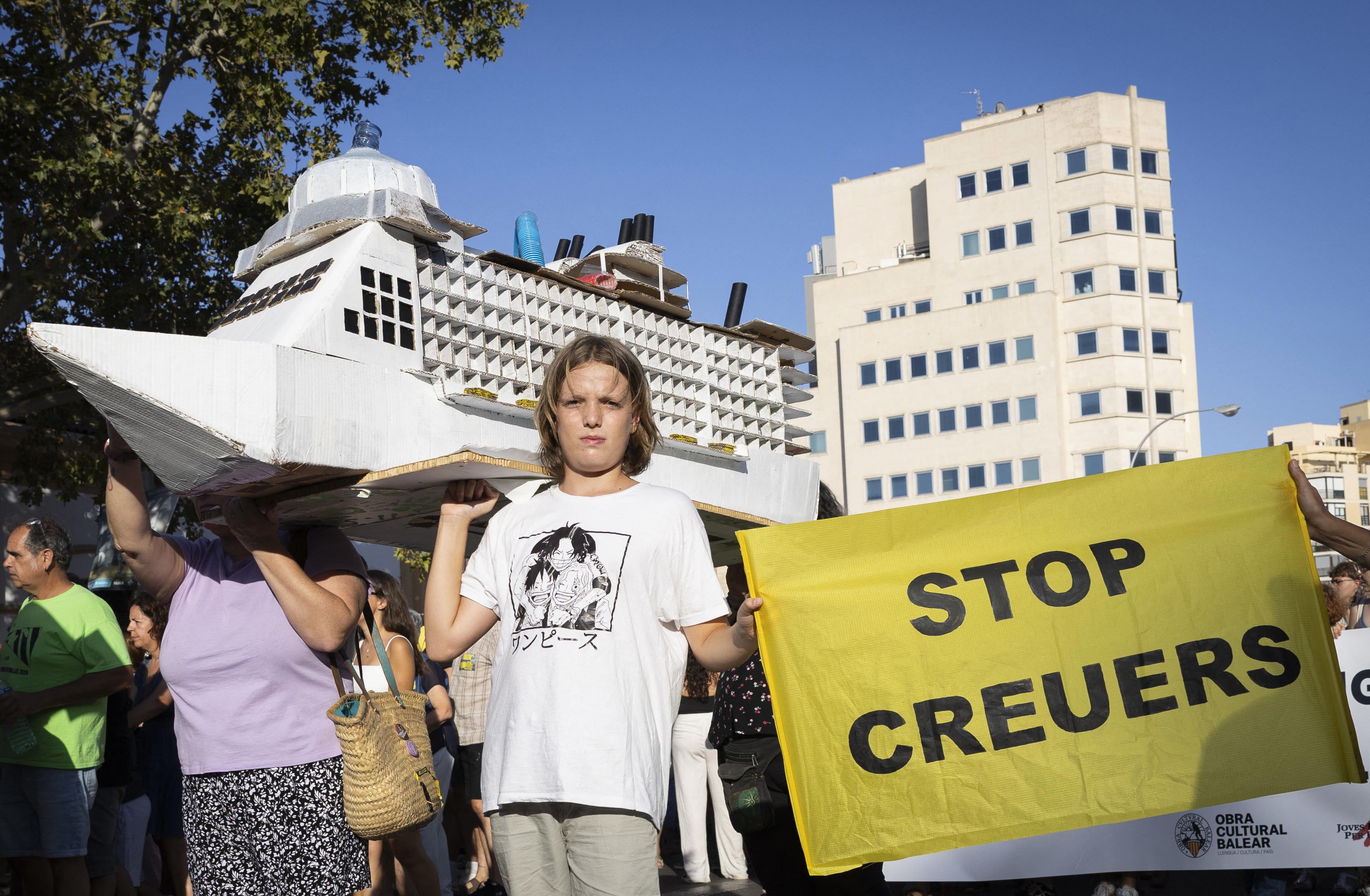The summer Europe turned on tourists
6 min read
Somewhere between the water pistol attacks in Barcelona, the hunger strike in the Canary Islands, new fees in Venice and cruise ship restrictions in Greece, it’s become clear: locals in many of Europe’s most popular destinations are sick of tourists.
Overtourism concerns have been on the rise for years, well before the coronavirus forced borders to temporarily close. After a pandemic pause, the breakneck return of overwhelming crowds has provoked strong reactions. This summer, a more vocal, fed-up populace struck back in new ways.
“We saw a lot more protests and a lot more people going on the street saying, ‘Enough is enough. Go away, tourists,’” said Sebastian Zenker, a tourism professor at Copenhagen Business School.
Protesters held one of the season’s most high-profile demonstrations in Barcelona in July, wielding water guns and forcing bewildered tourists to flee from restaurant patios. Residents carried signs saying “Mass tourism kills the city” and “Tourists go home” and told reporters that locals could no longer afford to live there. A manifesto published by advocacy groups asked the city to reduce the number of cruise terminals, cut back airport activity, ban short-term vacation rentals and stop using public money to promote the city to visitors.
Global tourism this year is expected to fully recover from the pandemic, according to U.N. Tourism; international arrivals reached 1.5 billion in 2019. And while destinations around the world have struggled with the influx, the angst is especially high in Europe this summer. Spain alone saw more than 53 million visitors through July of this year, a 12 percent increase from 2023, according to official tourism statistics.
Rachel Dodds, a professor in the hospitality and tourism management school at Toronto Metropolitan University, said she had warned that tourism would “come back worse than ever” after the pandemic lull, especially in destinations that didn’t rethink their approach.
“It was like a prophecy that came true,” she said.
Cities fight back
During pandemic shutdowns and travel restrictions, many cities struggled with the lack of tourist dollars. But residents of in-demand destinations also got to experience a more peaceful, less crowded version of their homes — making the whiplash of “revenge travel” more extreme.
Dodds, who runs a consulting firm called Sustaining Tourism, said many local leaders who had been concerned about the consequences of tourism focused on getting visitors back instead of building a more sustainable model.
While many destinations have said they are not opposed to tourism in general, they are attempting to control it — or at least wring more money out of visitors for their trouble.
Greece’s prime minister said this month the country will impose a 20-euro ($22) tax on cruise ship visitors to Santorini and Mykonos during the busiest summer season starting next year. The mayor of Santorini, a picturesque island that has been overwhelmed by tourists seeking selfies against a backdrop of white buildings and blue roofs, is recommending a limit of 8,000 cruise ship visitors a day, about half of what the island might see on very busy days, according to Reuters.
Locals have complained that too many people flood into the island in a short window, but not enough are booking longer, more lucrative overnight stays.
Calling the cruise industry “a success story” for the Greek economy, the Cruise Lines International Association questioned “the singular focus on cruise tourism for this proposal” in a statement. The trade group said it would keep working with local officials on tourism management measures and urged the government to hold off on the new fee until 2026.
Venice, which saw overnight visitor numbers reach a record 3.5 million last year, trialed a new 5-euro fee for day-trip tourists on certain days between late April and July. The fragile canal city has also announced a limit of 25 people for guided tour groups and a ban on loudspeakers.
Megan Epler Wood, managing director of the Sustainable Tourism Asset Management Program at Cornell University’s SC Johnson College of Business, said that in some cities, residents’ complaints reflect annoyance that tourists have inundated their towns. But others, like those in the Canary Islands, reflect greater concerns about unaffordable housing and strained environmental resources.
“They were people that just can’t live like that anymore,” she said, referring to the low wages and a high cost of living. Epler Wood said protests are a way to capture a media spotlight — and the focus of authorities who might be able to respond.
“I think politicians themselves are feeling the pressure, and so the citizens are doing even more to get their attention,” she said.
Barcelona’s mayor said in June that vacation rentals would be banned by late 2028, and a tourist tax is increasing from 3.25 to 4 euros a night.
Moneymaking machine
Governments have clashing interests when it comes to tourism, especially when their economies are highly dependent on visitor dollars. According to the European Union, tourism accounts for 10 percent of its gross domestic product.
A July report from the European Travel Commission shows that foreign arrivals for the first half of the year had surpassed 2019 levels, and visitors were expected to spend more than 800 billion euros this year, an increase of 13.7 percent compared to last year. Spain, Greece, Italy and France saw the biggest jumps in spending by tourists, the report said.
When government officials see tourists as walking dollar signs, they might not be considering what residents have to give up in exchange for mass tourism, said Christopher Gaffney, a professor at New York University’s Tisch Center of Hospitality. Those sacrifices include peace and quiet, the ability to move freely through their streets, access to cultural sites and, most importantly, affordable housing and a manageable carbon footprint.
Gaffney said residents in places like Barcelona, Florence or Lisbon are finding those places are “increasingly unaffordable because of tourist-driven gentrification pressures.”
“And that includes everything from food to bars to concerts and then the mere physical pressure of all those people in their daily life,” he said. “It’s not nice. No one likes hanging out in Times Square; it’s disgusting.”
Around the world, destinations have sought to keep numbers in check by increasing the cost of a visit — with several raising, reinstating or introducing new taxes or fees this year. Many cities and countries have focused on attracting higher spenders.
Epler Wood said she has been studying policies in Rwanda, where the price to track mountain gorillas with guides has doubled, to $1,500, with strict limits on how many people can participate. Yet demand has stayed strong. She called it “one of the best examples that I’ve seen in the world of high-value, low-volume tourism.”
Can anything stop overtourism?
According to the Sustainable Tourism Asset Management Program, taxes and fees probably don’t do much to deter visitors.
“Most research shows that an additional tax does not lower arrivals,” the program says in a fact sheet released in response to tourism concerns this year.
In the case of Venice, Reuters reported that opponents of the day-trip fee called its trial a failure because the city was still teeming with tourists. Officials have said they intend to bring it back next year, potentially at a higher price and for more days.
For people determined to mark the city off their bucket list, Dodds said she doesn’t expect an added charge to make a difference.
“If you’ve never been to Venice, you will go, no matter how much it costs,” she said. “No matter how terrible the experience.”
Gaffney said politicians could use other levers: charging airlines more to land at airports, for example, leading to higher fares that might keep more travelers away.
“Air travel is kept artificially low; you’ve encouraged them to come,” he said. “And so why are you shocked? And then you charge them a fee.”
Tourism experts didn’t expect much to change next summer, despite the attention on anti-tourist sentiment.
Zenker said the life cycle of tourism often sees places gain popularity, then become too popular and fall out of favor. He said that could happen in theory, but in reality he expects Europe’s top draws to keep attracting tourist hordes, once again leaving authorities searching for answers.
“We will have the same discussion next year,” Zenker said.



